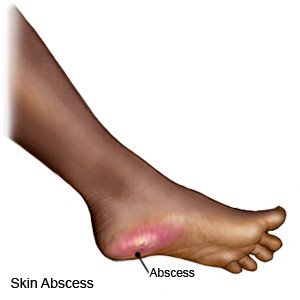Abscess in Children
Medically reviewed by Drugs.com. Last updated on Aug 4, 2025.
An abscess is an area under your child's skin where pus (infected fluid) collects. An abscess is often caused by bacteria, fungi, or other germs that get into an open wound. Your child can get an abscess anywhere on his or her body.
 |
DISCHARGE INSTRUCTIONS:
Return to the emergency department if:
- Your child has a fever and chills.
- The area around your child's abscess becomes more painful, warm, or has red streaks.
- Your child is more tired than usual or feels faint.
Call your child's doctor if:
- Your child's abscess gets bigger.
- Your child's abscess returns.
- You have questions or concerns about your child's condition or care.
Medicines:
Your child may need any of the following:
- Antibiotics help treat an infection.
- Acetaminophen decreases pain and fever. It is available without a doctor's order. Ask how much to give your child and how often to give it. Follow directions. Read the labels of all other medicines your child uses to see if they also contain acetaminophen, or ask your child's doctor or pharmacist. Acetaminophen can cause liver damage if not taken correctly.
- NSAIDs , such as ibuprofen, help decrease swelling, pain, and fever. This medicine is available with or without a doctor's order. NSAIDs can cause stomach bleeding or kidney problems in certain people. If your child takes blood thinner medicine, always ask if NSAIDs are safe for him or her. Always read the medicine label and follow directions. Do not give these medicines to children younger than 6 months without direction from a healthcare provider.
- Do not give aspirin to children younger than 18 years. Your child could develop Reye syndrome if he or she has the flu or a fever and takes aspirin. Reye syndrome can cause life-threatening brain and liver damage. Check your child's medicine labels for aspirin or salicylates.
- Give your child's medicine as directed. Contact your child's healthcare provider if you think the medicine is not working as expected. Tell the provider if your child is allergic to any medicine. Keep a current list of the medicines, vitamins, and herbs your child takes. Include the amounts, and when, how, and why they are taken. Bring the list or the medicines in their containers to follow-up visits. Carry your child's medicine list with you in case of an emergency.
Care for your child:
- Apply a warm compress to your child's abscess. This will help it open and drain. Wet a washcloth in warm, but not hot, water. Apply the compress for 10 minutes. Repeat this 4 times each day. Do not press on an abscess or try to open it with a needle. You may push the bacteria deeper or into your child's blood. If your child's abscess opens, cover it with a bandage as directed.
- Do not share your child's clothes, towels, or sheets with anyone. This can spread the infection to others.
- Wash your hands and your child's hands often. This can help prevent the spread of germs. Use soap and water or an alcohol-based hand rub.

Care for your child's wound after it is drained:
- Care for your child's wound as directed. If your child's healthcare provider says it is okay, carefully remove the bandage and gauze packing. You may need to soak the gauze to get it out of your child's wound. Clean your child's wound and the area around it as directed. Dry the area and put on new, clean bandages. Change your child's bandages when they get wet or dirty.
- Ask your child's healthcare provider how to change the gauze in your child's wound. Keep track of how many pieces of gauze are placed inside the wound. Do not put too much packing in the wound. Do not pack the gauze too tightly in your child's wound.
Follow up with your child's healthcare provider in 1 to 3 days:
Your child may need to have the packing removed or the bandage changed. Write down your questions so you remember to ask them during your visits.
© Copyright Merative 2025 Information is for End User's use only and may not be sold, redistributed or otherwise used for commercial purposes.
The above information is an educational aid only. It is not intended as medical advice for individual conditions or treatments. Talk to your doctor, nurse or pharmacist before following any medical regimen to see if it is safe and effective for you.
Further information
Always consult your healthcare provider to ensure the information displayed on this page applies to your personal circumstances.
